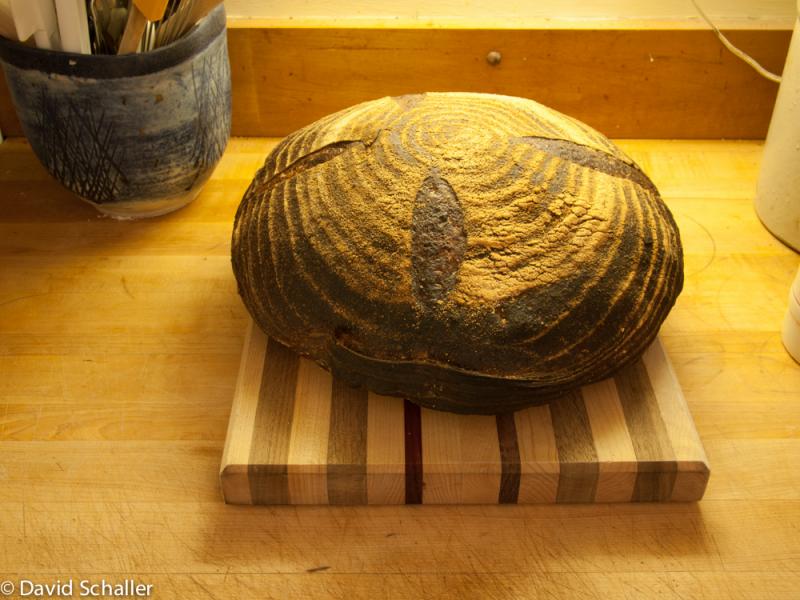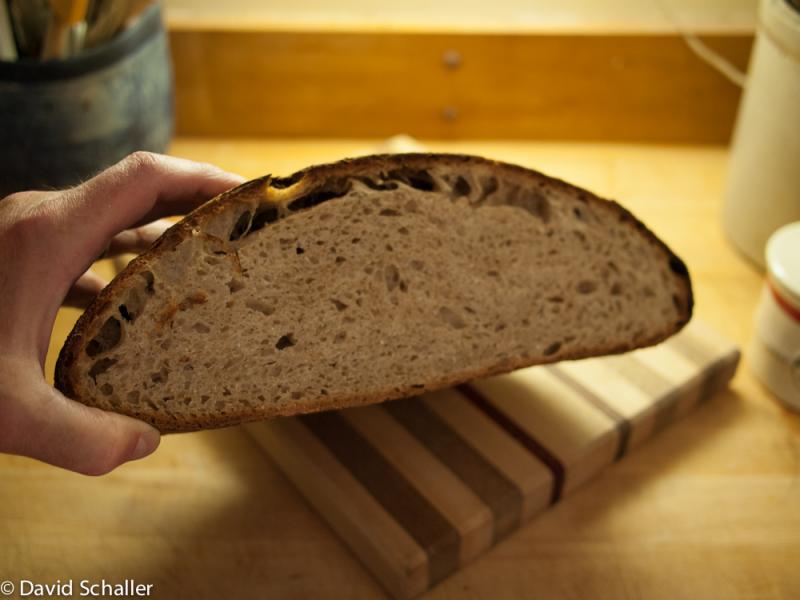
With a couple of rainy days in the forecast, and nice weather to follow, I attempted another miche. I followed dmsnyder's formula again, but with two changes. First my baking timetable was different. I had my liquid starter ready to go from a previous bake, so I made up the preferment in the morning, let it work all day, then mixed, bulk fermented and so forth in the evening, putting the shaped loaf in the refrigerator after midnight. Secondly, I replaced about 18 percent of the AP flour with half whole wheat and half whole rye in the final dough. I added a bit of extra water, and one more stretch and fold to account for the increased whole grains.
I took the loaf out of the refrigerator at 8:30 a.m. and pre-heated the oven. Since it was very warm and humid in my kitchen (like 95% humidity!), I loaded the loaf at 9:30, after an hour at probably 80F. Again I had trouble getting the wet dough out of the brotform, and this time it created a tear, even with heavy rice/AP flouring. So definitely the next time I try this I am going to do the final proof in a heavily-floured, linen-lined colander!
I baked in my ordinary oven with steam for 20 minutes at 450F, then 20 minutes more, then lowered the oven to 420 for the final 20 minutes as the loaf was already very dark. Again I waited 24 hours before slicing. The results are in the pictures. My question for the experts is, does the big hole underneath the crust indicate under proofing? Whereas my first attempt was probably in the refrigerator for 16 hours, then an hour at room temperature, this was in the frig for 8 hours only.
The bread tastes great of course; I like the taste impact of the added whole grains. But I would like to correct the large holes underneath the crust.
Thanks again for this wonderful site!
Dave


with half rice and half AP I now use only rice flour and never have a problem.
I think it is a shaping problem with the holes under the crust.nalke sure you are pre-shaping and then 10 minutes later final shaping properly. KA's website or YouTube have some great videos on shaping.
Your bread has to be tasty. It sure looks great. Well done! I too add rye and whole wheat, 10% each to David's great recipe, for the flavor and increased sour too. I put them in the levain to try to get the whole grains as wet for as long as possible. The big holes suffer but I want a more tasty and healthy bread first for personal health reasons. Have recently added whole farro and spelt to the mix and used 7% each for the 4 whole grains.
Happy baking
Thank you for your diagnosis. I will try flouring with only rice flour the next time. And it is indeed difficult to shape such a large, wet and sticky dough! I did do a pre-shape, 20 minute bench rest, then final shaping. Maybe a shorter bench rest would keep this dough from relaxing too much. I didn't add the whole grains into the preferment because I didn't want it to ferment too fast in the warm weather, but I may try that the next time as well for the softening it would provide, especially if I can be around to watch it in the daytime.
Thanks again,
Dave
levain. My Arizona kitchen is 80 F minimum too. If I start with 15 g of stiff starter ( I go for sour so use a small amount of stiff, 66% hydration, whole grain starter that is in the fridge for at least 3 days prior) the first build is 15 each flour and water about - 3 hours in the summer. Second build is 30 g each flour and water for another 3 hours. Third build is 60 g each flour and water and I refrigerate it for 24 hours, to promote sour and fit my schedule, after it has risen 25% - about an hour. This gives me 195 g of starter for David.s big loaf - plenty in the summer.
When I want the levain to be ready, I take it out of the fridge 4 hours before i need it so that it has time to warm up and finish doubling in volume to be ready to do its thing in the dough. It can be in the fridge shorter or longer to fit any schedule. The Fridge Is Your Friend! I always wanted to put that on a baker friendly t-shirt. Maybe Floyd will have some of them to sell in his online store one day?
Iv'e started my take on David's San Joaquin where i am not using any whole grains at all - a real change for me. I did mill a 33% split of farro, WW and spelt though and sifted it to 75% extraction for Friday's bake. Still I will autolyse for 4 hours - I'm going for white bread holes this time -maybe 80% hydration since this flour combination is thirsty. :-)
David's recipes are fool proof once you bake them a few times and account for the temperature differences in his kitchen and the time of year.
Happy baking
I want to try the San Joaquin sourdough too! Thanks for your comments.
Dave
I love the bold bake and the scoring.
I have read that that sort of crust separation can be caused by over-proofing and by lax shaping. I very rarely get it myself. When I do, it is related to over-proofing, I'm pretty sure.
Shaping a sticky dough is tricky, but, once you know the tricks, it's not so hard.
I'm glad you like this bread, and I hope you enjoy the San Joaquin Sourdough as well.
Happy baking!
David
Great looking miche, bet it tasted wonderful!
FWIW, my take on the holes under the crust issue is that it is related to a deficit in structure. The deficit can be from:
-Under-developing the gluten/structure to begin with, particularly in a wet dough (not enough kneading or doing enough folds).
-Allowing the fermentation to go too long so that what started out as an adequate structure comes under attack from enzymes and acid, while at the same time gas production is amplified- the dough no longer has enough strength to contain the excess gas.
-Not proofing upside down or not tightening the skin enough during shaping.
Hope something there helps. I've noticed this problem pops up more during the summer.
I really appreciate your help. Aha, now I see! I'm pretty sure that the bulk fermentation went too long. Although I had anticipated that the increased whole grains would require an extra stretch and fold, I did not take into account that the rate of fermentation would also be increased by the whole wheat and whole rye (and the heat and humidity in my kitchen)! And of course shaping was an issue, which I hope will improve with more experience with this higher hydration dough.
I will certainly incorporate your suggestions into my procedures the next time I make this bread. In my mind it is a high risk/high reward enterprise, so I will keep trying until I get it worked out.
Thanks again for your attention,
Dave